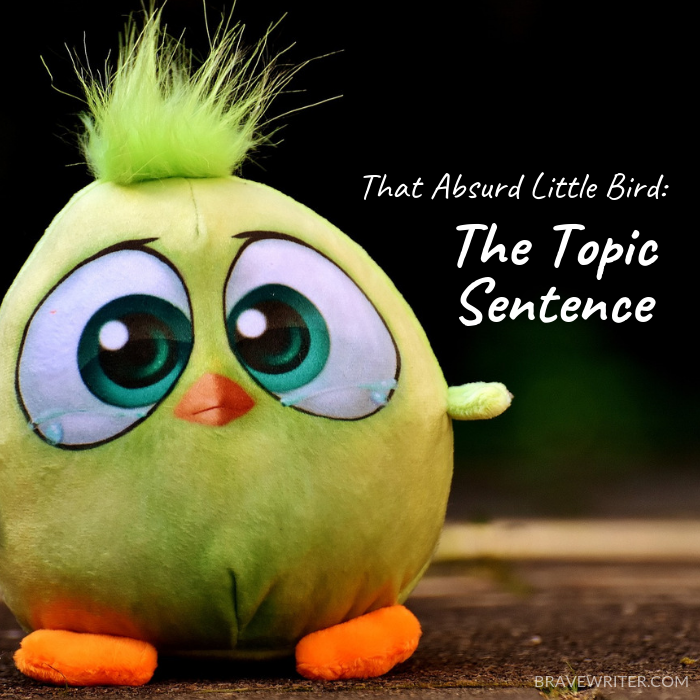That Absurd Little Bird: The Topic Sentence

If you want to see my dyed gray hair stand on end, talk to me about the importance of the initial topic sentence.
“My left earlobe is very attractive for three reasons.”
“I like anchovy ice cream more than pizza.”
“Captain Diaperpants is an entertaining book and I highly recommend it.”
Need I go on? ::yawn::
Truth is: The topic sentence is to the paragraph what support hose are to varicose veins. We don’t really want to be aware of the work they’re doing. They offer support, yes, but why announce that fact to the world? The best ones are hidden in the compelling-to-read prose.
I was lurking on the Internet and read a whole bunch of sample paragraphs on a writing site for homeschooled students. The curriculum writer stressed the importance of both the topic sentence and structured, orderly writing as hallmarks of correct writing. She then conceded that this kind of writing would be “stiff and stilted and even boring in most cases,” but it didn’t matter. Didn’t matter? In what universe? The point was to learn to write these orderly, cardboard, stiff, spiritless, uninspired, i-n-s-i-p-i-d paragraphs (::grinding teeth::) with duty and diligence no matter how painful to the reader.
Oh break my writerly heart!
Reverse the curse of the initial topic sentence.
Here’s how:
- Start in the middle.
Don’t tell me all I need to know in the first sentence. Once I find out that you are a black belt in karate, what interest do I have in reading how you earned the belt? Start with the struggle, facing the board as you prepare to sever it in half as with a cleaver. Leave me hanging out there, flapping in the breeze, worried and curious.
- Get me involved.
Use sensory detail to suck me into the scene without revealing your point until I’m hooked: “I sneezed when I leaned over the basket of cumin to examine it for bugs. The spicy fragrance reminded me of kasbahs and Moroccan stews. Unfortunately, I found myself in a modern Farmer’s Market in downtown Cincinnati instead. I miss North Africa.”
- Put the main idea at the end of the paragraph.
Most freewriting will start with a typical topic sentence that generalizes about the subject for writing. That’s fine when getting your thoughts together. To help hide the know-it-all sentence when you revise, move it to the end and see what happens. Like in the sample above—the topic sentence is last to appear. It’s so much happier modestly revealing itself at the end.
I know, I know. I didn’t even talk about the all important topic sentence in academic writing or in subsequent paragraphs. We’ll get to that another day.
For now, hook me, seduce me, scare me, move me, grab me by the collar, and don’t let me go. Lure me into your writing by concealing the point. That’s the point! (And that second-to-last sentence you just read, the one pretending not to be a topic sentence, is the topic sentence for this piece, artfully concealed until the end, incidentally…)



















Hiding the topic sentence at the end of the paragraph for the first paragraph in a piece (like your sample paragraph above where you “hook” the reader first) is actually how I was taught in an AP English class in high school (1980-1983.) But only for the intro paragraph. (We spent 3 years working on the 5-paragraph essay as a “timed” writing – basically done in a single class period as an in-class exercise. All to prepare for that AP English exam.)
We were taught that the intro paragraph should “hook” the reader and that the last sentence of the paragraph should be our “three-pronged thesis” that will set us up for our 3 body paragraphs of the 5-paragraph essay. Then we would have our concluding paragraph, where we would “restate” our thesis in a different way and try to end the piece (my hardest part.) Of course, none of my high school essays were as lively as your example paragraph, but I am glad that I was at least taught one good method in that class!
I’ll tell you what universe it doesn’t matter in. The SAT writing test. There’s been a discussion about it on a list I’m on (populated by academics wanting to leave academe) and there is a general depression setting in at the inability of most college students to write.
You go girl. Your advice is EXACTLy what is needed.
I couldn’t agree more with your direction. I have seen my kids grow in their eagerness to capture the readers attention. However, my daughter who is no longer afraid to write (thanks Julie), will likely be entering high school and I already have a copy of the sheet given out by the English teachers which “FORMATS!” the topic sentence. It’s like tasting and retasting consumme soup over and over again until your taste buds scream for something more flavourful. What do I do to help keep my daughter on track while still submitting to a teacher’s request?
This was an interesting analogy. However i also sometimes “hide” my topic sentence at the end of the first paragraph.
My 8 y.o. and I were checking out some games on an educational software suite I bought for her, and one of them was on paragraphs. It taught her that paragraphs started with the topic sentence, had 2-3 “supporting sentences,” and then finished with a single concluding sentence. Although we’ve done very little formal grammar/writing lessons, even she could see that this certainly didn’t describe ALL paragraphs.
Do I ever remember being drilled and grilled over the topic sentence in school. Fortunately, your blog is helping me break many curses – topic sentence placement, the next one to be zapped!! Thanks much.